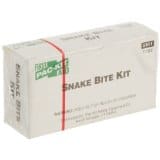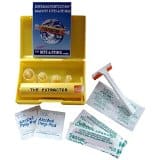 UPDATE: Because of the last few years of data we actually no longer support the use of snake bite kits to treat a venomous snake bite. In fact, we very much advise against it. Read THIS ARTICLE to learn why.
UPDATE: Because of the last few years of data we actually no longer support the use of snake bite kits to treat a venomous snake bite. In fact, we very much advise against it. Read THIS ARTICLE to learn why.
If you asked a group of people what their biggest outdoor fear would be, there’s a very good chance that snake bite will be near the top of the list. Unless you live in Maine, Hawaii, or Alaska, there’s a possibility of a venomous snake bite anywhere in the United States. Looking up information online or speaking to the local DNR office is probably the best way to figure out what venomous snakes might be in the area (rattlesnakes, copperheads, and water moccasins are the most common ones you’ll need to worry about) and to learn more about how to avoid them and protect yourself if you are going to be in their habitat.
Prevention is the ideal best case situation, but sometimes despite careful actions and protection from clothing like snake boots or snake proof chaps,
Being out in the wild and enjoying nature is a critical part of growing up for many boys, all of whom have fond memories of camping with family, friends, or scouts, and go out for the weekend surrounded by woods or mountains. The smell of a campfire, the taste of hot food off the fire on a cold morning, unexpected wildlife sightings – these are all amazing experiences that stick out in the mind of a child long after they’ve made their way into adulthood.
However, you still need to be prepared for every potential problem or situation that might occur. This includes mental preparation as well as actual first aid kits and other special tools and items that can help when those worst case scenarios become unfortunate realities.
Being prepared for the worst case scenario

One of the most important first steps is to start with the mental game and mental preparation. There’s a reason that kids in Boy Scouts are required to learn first aid at every rank level. Even young children can learn the very basics of first aid, and they should. This is powerful information that can be life saving as even the most basic of first steps can make the difference between life in death in an emergency situation. No one likes to think about a worst case scenario, but it’s extremely important to be prepared for them.
One popular option is to go with a training course. There are many first aid/CPR courses that are offered by paramedics or local organizations, and you might even be able to connect with a Boy or Girl scout troop in the area that is doing training for the kids. Another option is having a good picture guide in book form that helps teach the basics.
When it comes to actually treating venomous snake bites, since that tends to be a specialty situation, you may need to get specific training. This includes the basic first aid of knowing how a constrictor band works and why to avoid tourniquets, to understanding how the snake bite first aid kit works and how to use it.
Training matters because that knowledge is what allows you to properly use the right tools to get out of a potentially dangerous situation.
To handle the tool or physical product side of things when dealing with camping and outdoor safety, you want to be comfortable with them and train with them before you ever find yourself in a life or death situation. The minutes after being bitten by a venomous snake, for example, are not the time to try to find instructions for how to use the kit to suck out the venom – if you’re going to treat your snake bite with a quality kit then time is a major factor and sooner is much better than later!
Equipment you should always have along includes:
- Standard first aid kit
- Bite and sting kit for snake bites or bee stings
- Cell phone to call for medical assistance
- Clear map or knowledge of the quickest way to the nearest medical facility.
Snake bite treatment can take many phases, and it’s important to note that any snake bite can be extremely dangerous because of heavy possibility of infection or allergic reaction to any saliva or other substances that are transferred from a snake’s mouth to the wound. This alone is reason to get medical attention after the fact but when it comes to venomous snake bite treatment, getting the full treatment is just the beginning.
Getting down to treating your snake bites
The first step here is to immediately move away from the venomous snake or snakes that were aggressive enough to bite. The last thing you need is one venomous bite to turn into multiple bites. This definitely speeds up the process of getting sick and even dying, and if you turn out to be allergic to snake venom (yes, there are allergic reactions that stack up damage and health issues in addition to the damage that the venom itself will do) then one bite is already too much and speeds up the clock for action – more can be quickly fatal.
Once you’re clear of the immediate danger, then you stop in a safe place and begin immediate first aid treatment. While it’s going to be hard, you will need to breathe deeply and do your best to keep calm. An elevated heart beat is not your friend in these situations! If you have taken the precaution of buying one of the best snake bite kits, you can break that out immediately and clean up the area of the bite, suck out some venom, and disinfect the area before wrapping it up.
Don’t mistake this for full treatment – you should always seek hospital or clinic care after a snake bite including anti-venom and any other treatments the doctor sees as being necessary in order to get the damage under control. Even if you do everything right, there’s no guarantee that you will come out of the situation unscathed. There are many real life examples of injured limbs, permanent limb damage, and a variety of other issues that resulted because of the side effects of a snake bite.
Common ailments from a venomous snake bite are nothing to be messed with. Even “minor” effects from a venomous snake bite can be life changing and horrific, while infections that come from non-venomous snake bites can be equally as devastating when left untreated or not properly treated. The initial first aid is important, not only for the treatment itself but for the way taking that action often has a calming effect on the bitten individual and allows him or her to slow down the heart rate, focus on what he or she is doing, and that calmness allows clear thinking, clear action, and a better chance of ending up safe since the slower heart rate will slow the spread of venom.
One thing that’s often worth noting is that there is some degree of controversy about the overall effectiveness of these kits and whether they work or not with some people being strongly for them and some being strongly against them specifically when looking at snake bites. When using these types of extractors for insect stings or poisonous spider bites, there seems to be a stronger consensus with these kits being more effective.
Sifting through conflicting expert testimonies is always difficult, but many hunters, survivalists, and other outdoor specialists often talk about having it on hand for those just in case scenarios.
In Conclusion
Getting treatment as quickly as possible is important in any snake bite case. Fast treatment on-site, followed by fast transportation to the nearest hospital, can make all the difference when it comes to coming out of the situation as healthy as possible.
Prevention is always better than going with treatment, which is one reason we’re so big on this snake proof boot review website. If you manage to keep yourself from getting bitten at all, that’s definitely better than having to get treatment, but if the worst happens, make sure you’re prepared to treat a venomous snake bite the right way so you’re not paying for it later!